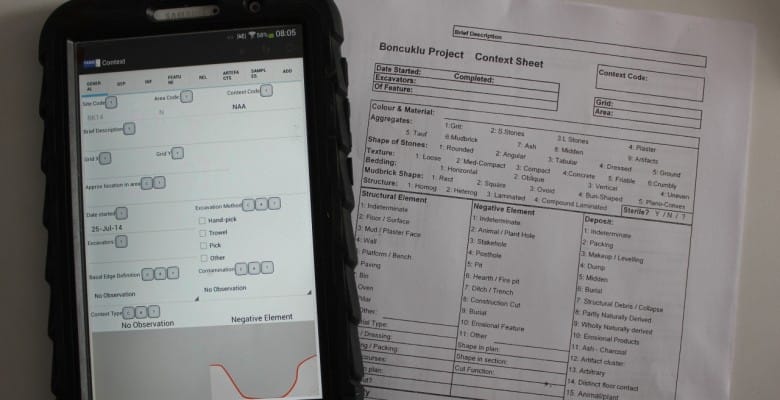Archaeology involves recording a lot of information about the site and its finds. These records form the basis of our analysis and the long term archive which can be used by future generations to understand our finds. At Boncuklu we use a single context recording system in which every archaeological entity (structure, sediment layer, cut) is recorded individually with details of shape, size, contents etc. Written records are appended by drawings and photographs, meaning that we have a lot of information to organise and archive.
 FAIMS-in-a-box at Boncuklu
FAIMS-in-a-box at Boncuklu
Until 2014 we have used a paper recording system to record all primary information but during this field season we are trialing a new electronic recording system developed by the Federated Archaeological Information Management System (FAIMS – https://www.fedarch.org/wordpress/) based at the University of New South Wales in Australia. Using the FAIMS excavation module – funded by NeCTAR and ARC LIEF grants – on Android tablets (see photo) will allow rapid data entry to our database without the need for typing up paper sheets and allow us to seamlessly record audio and video files into records for the first time. Data entered at the trenches will be stored instantaneously on a server in the BK dighouse via a dedicated wireless network facilitated by our very own FAIMS-in-a-box system (see photo). FAIMS-in-a-box is an off-the-shelf system developed by Solutions First of Sydney, Australia and consists of an integrated server, wireless transmitter and Android tablets. FAIMS is an open source platform and anyone interested in the system should contact the development team.
The system was tested successfully at Boncuklu on July 23rd and the FAIMS team is currently completing the final module edits. We plan to start using the module during excavation on August 4th after the Bayram holiday and will send updates in due course.




 Follow
Follow
at 12:03 pm
Looking forward to your updates on how the system copes with multiple users and compilation. Great work. Have you considered voice entry technology ? Maybe one step or key stroke at a time first . Cheers Birgy